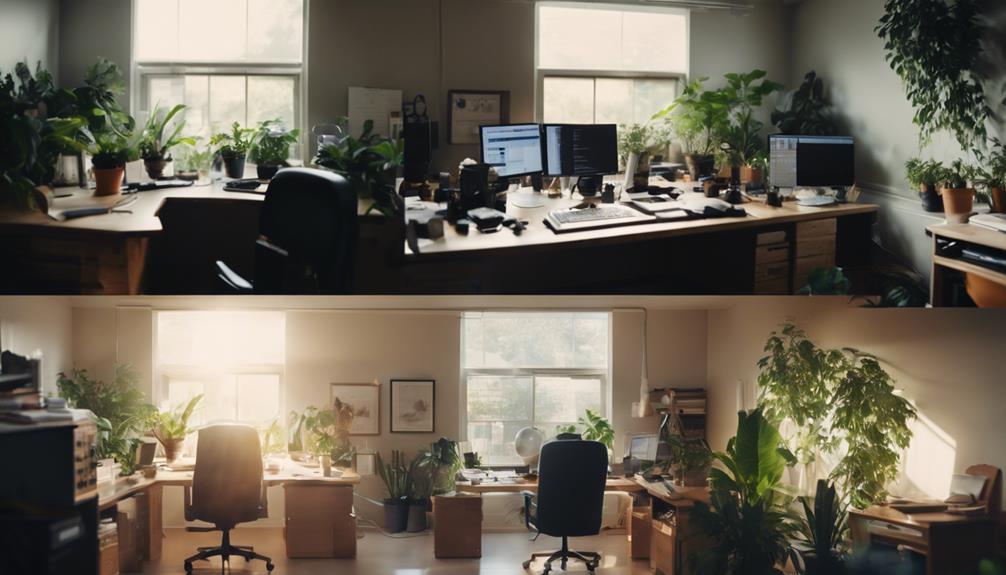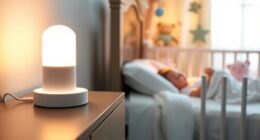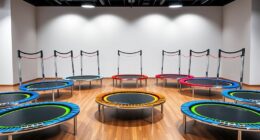When it comes to productivity, choosing between home and office can be tricky. You'll find that the office promotes spontaneous teamwork and social interactions, sparking creativity. However, working from home minimizes distractions, allowing for deeper focus. While many reports suggest higher productivity at home, the best environment often combines both settings. Your personalized setup at home can enhance comfort, while office collaboration can boost team dynamics. Ultimately, it's about finding your ideal balance. Explore how these factors can optimize your work experience and support your productivity like never before.
Key Takeaways
- Office environments foster spontaneous interactions and teamwork, enhancing creativity and reducing stress through casual conversations.
- Home settings often provide fewer distractions, allowing for deeper concentration and increased productivity.
- A combination of both office and home work can optimize productivity by leveraging the strengths of each environment.
- Well-designed workspaces, whether at home or in the office, significantly impact focus and overall task efficiency.
Defining Workplace Productivity
Defining workplace productivity involves understanding how effectively you complete tasks while maximizing efficiency and minimizing resource use.
It's not just about the quantity of work done; it's also about the quality and effectiveness of your efforts.
You'll find that productivity can vary significantly across different organizations, so aligning your definition with specific business objectives is crucial.
High productivity benefits everyone—consumers, organizations, and employees alike.
By focusing on increasing efficiency, you enhance competitiveness and profitability, leading to a more stable work environment.
Recognizing the balance between productivity and effectiveness will help you meet deadlines and achieve goals more consistently, ultimately creating a more satisfying work experience for you and your colleagues.
Comparing Office and Home Productivity
When comparing productivity in the office and at home, it's essential to consider how different environments influence your focus, collaboration, and overall effectiveness.
In the office, you benefit from spontaneous interactions and teamwork that can energize you and spark new ideas. Casual conversations around the water cooler often lead to creative breakthroughs and can reduce stress.
However, at home, you might find fewer distractions, allowing you to concentrate deeply on individual tasks. Studies show that many employees report higher productivity while working remotely, partly due to eliminating commutes.
While both environments have their strengths, the ideal balance often lies in combining both settings to maximize your productivity and job satisfaction.
Environment's Role in Productivity

The environment you work in significantly impacts your productivity, shaping your ability to focus, collaborate, and innovate. A well-structured space can help you concentrate, while a cluttered or distracting area can hinder your progress. Consider the following factors:
| Home Environment | Office Environment |
|---|---|
| Quieter, fewer distractions | More frequent interruptions |
| Personalized comfort | Standardized settings |
| Flexible hours | Fixed schedules |
| Limited collaboration | Enhanced teamwork opportunities |
Effects of Workplace Design
Effective workplace design directly influences your productivity, shaping how you interact, focus, and collaborate throughout the day.
An open office layout might seem inviting, but it can decrease your productivity by 30% due to distractions. Conversely, ergonomic furniture boosts your comfort and can lead to a 25% increase in efficiency.
Natural light is another crucial element; it can elevate your mood and enhance productivity by 15%. Incorporating biophilic design elements, like plants, reduces stress and improves focus.
Additionally, dedicated collaborative spaces foster teamwork and enhance problem-solving skills. Ultimately, a well-thought-out office design not only increases your productivity but also enhances your overall job satisfaction, making your work environment more appealing and effective.
Technology's Impact on Efficiency

Technology enhances efficiency by streamlining workflows and facilitating seamless collaboration among teams. You can leverage various tools to significantly boost your productivity, whether you're at home or in the office. With the right technology, you can automate repetitive tasks, communicate instantly, and access files from anywhere.
| Technology Tool | Benefits | Impact on Efficiency |
|---|---|---|
| Collaboration Software | Real-time teamwork | 40% increase in communication effectiveness |
| Automation Tools | Reduces time on repetitive tasks | Up to 50% time saved |
| Cloud Storage | Accessible from any location | Improves workflow speed |
| Video Conferencing | Enhances remote meetings | Boosts team connection |
Employee Well-being and Productivity
How does prioritizing employee well-being directly influence productivity levels in the workplace?
When you feel supported and valued, your motivation and engagement soar. Focusing on well-being can lead to impressive outcomes, such as:
- Mental Health Support: Access to mental health resources can boost job performance by 60%.
- Work-Life Balance Initiatives: These can increase employee satisfaction by 30%, making you more dedicated to your work.
- Regular Breaks: Taking breaks helps improve focus and reduce burnout, ensuring you're always at your best.
Future of Work Environments

The future of work environments is shaping up to be more flexible and employee-centric, responding to the diverse needs and preferences of the workforce.
You're likely to see a rise in hybrid models, blending remote and in-office work. This approach not only boosts productivity but also enhances work-life balance. Employers are reimagining their strategies to accommodate this shift, ensuring flexibility while maintaining collaboration. To support this, companies are investing in ways to maximize productivity with office designs, creating spaces tailored for teamwork, creativity, and focus. By merging the benefits of remote work with well-structured in-office environments, businesses are fostering a more engaged and satisfied workforce.
Moreover, organizations are investing in collaborative spaces and ergonomic designs that promote comfort and creativity.
With technology playing a crucial role, tools for seamless communication and project management will become standard.
You'll also notice an emphasis on sustainability and wellness initiatives, which support both employee satisfaction and productivity.
As a result, your work environment will evolve into a space that fosters autonomy and engagement, ultimately driving success.
The Rise of Flexibility in Work
Flexibility in work arrangements has become essential, allowing you to tailor your job experience to fit your personal and professional needs. This shift empowers you to choose how and where you work, leading to increased satisfaction and productivity.
Here are three key benefits of flexibility:
- Work-Life Balance: You can better manage your personal commitments while staying productive at work.
- Increased Motivation: Having control over your schedule often boosts your enthusiasm and drive to complete tasks.
- Reduced Stress: Flexible arrangements can minimize the stress of long commutes and rigid office hours.
As workplace flexibility continues to rise, it's clear that adapting to your unique preferences can enhance both your productivity and overall well-being.
Embrace this change and take advantage of the opportunities it brings!
Conclusion
In the end, whether you find your flow at home or in the office hinges on your unique needs and preferences.
At home, you enjoy peace and flexibility, but risk isolation; in the office, collaboration fuels creativity, yet distractions abound.
By recognizing how each environment influences your productivity, you can make informed choices that enhance your performance.
Ultimately, it's about striking a balance—embracing the best of both worlds to create a work life that truly thrives.










